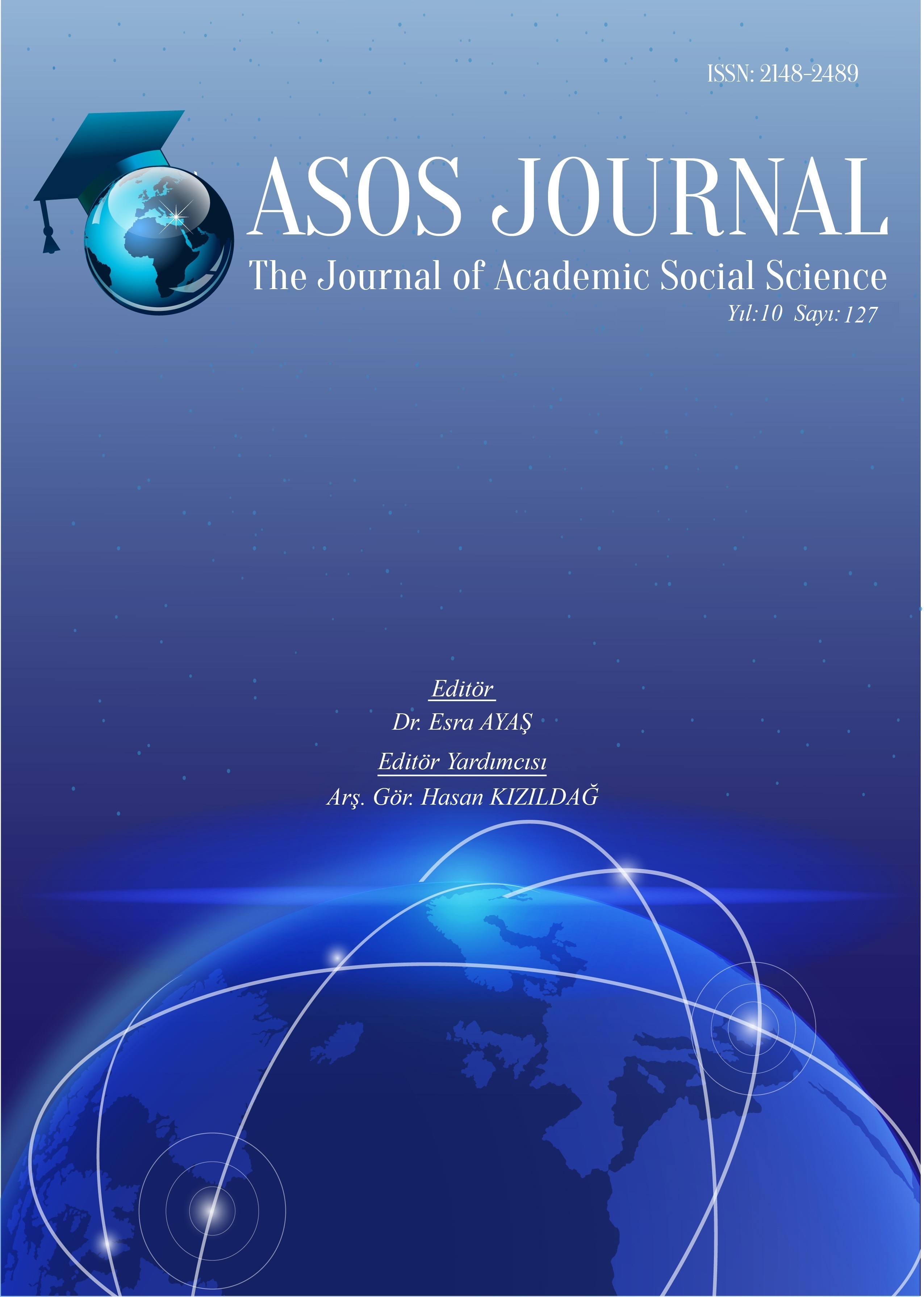Author :
Abstract
Çocuk şarkılarının, müzik eğitiminde kullanılmasının temel amacı Doğu’dan Batı’ya, okulöncesi çağlardan ortaöğretimin son basamaklarına kadar her öğrenciye eğitimde fırsat eşitliği sağlayabilmesidir. Bu noktada müzik eğitiminin temel yapıtaşı niteliğinde olan çocuk şarkılarının içerdiği değerler, bu şarkıların ses sınırları gibi unsurların iyi müzik öğretmenleri tarafından bilinmesi ve çocuk şarkısı havuzundan gerekli zamanda doğru şarkıyı seçebilmeleri beklenmektedir. Çocuk şarkısı dağarına (repertuvarına) en çok ürün kazandırmış eğitim müziği bestecilerinden Salih Aydoğan’ın eserlerinin eğitim müziği ekseninde incelenmesi çocuk şarkısı havuzunun büyük bir payının müzik öğretmenlerine kılavuz olması açısından önem arz etmektedir. Bu araştırmada Aydoğan’a ait 1961-2020 yılları arasında yazılmış 141 çocuk şarkısı künyeleri, ses sınırları, tonalite/modalite/makam durumları, UNESCO değerlerini içerme durumları ve tekseslilik/çokseslilik durumları açısından incelenmiştir. Araştırmada; şarkı sınırlarının genellikle Do4-La4 ve Do4-Do5 aralığında olduğu, şarkıların çoğunlukla teksesli ve tonal bestelendiği, şarkılarda en çok mutluluk ve sevgi değerlerinin işlendiği sonuçlarına ulaşılmıştır. Elde edilen sonuçlar ilgili başlıklar altında sunulmuştur. Araştırma sonucunda eğitimcilere, eğitim müziği bestecilerine ve araştırmacılara sonuçlara ilişkin şarkı kullanımı, ses sınırları ve değerler eğitimi üzerine önerilerde bulunulmuştur.
Keywords
Abstract
The main purpose of using children’s songs in music education is to provide equal opportunities in education for every student from the East to the West, from pre-school ages to the last steps of secondary education. At this point, it is expected that the values of children’s songs, which are the basic building blocks of music education, elements such as the sound limits of these songs are known by good music teachers and that they can choose the right song from the pool of children’s songs at the necessary time. Examining the works of Salih Aydoğan, one of the educational music composers who brought the most products to the children’s song repertoire, on the axis of educational music, is important in terms of being a guide for music teachers with a large share of the children’s song pool. In this research, 141 children’s songs written between 1961 and 2020 by Aydoğan were examined in terms of vocal ranges, tonality/maqam/modality, UNESCO values, and monophony/polyphony. In the research; It has been concluded that the song boundaries are generally in the range of Do4-La4 and Do4-Do5, the songs are mostly composed in monophonic and tonal, and the values of happiness and love are processed most in the songs. Obtained results are presented under the relevant headings. As a result of the research, suggestions were made to educators, educational music composers and researchers on the use of songs, sound limits and values education.
Keywords
- Alkar, R. (2008). İlköğretim Müzik Eğitimi Dersinde 2007-2008 Eğitim Öğretim Yılında Okutulan Öğrenci Çalışma Kitaplarındaki Şarkıların Müziksel Amaçları Bakımından Analizi. Yayınlanmamış yüksek lisans tezi, Dokuz Eylül Üniversitesi Eğitim Bilimleri Enstitüsü.
- Aydoğan, S. (1961). Bir Dünya Bırakın. (1. Baskı), Ayyıldız Matbaası.
- Aydoğan, S. (1982). Yaşasın Müzik. Önder Matbaa.
- Aydoğan, S. (1992). Hayat Kaynağımız Müzik Ortaokul 1-2-3. Arkadaş Yayınevi.
- Aydoğan, S., & Tunçer, H. (1988). Ezgilerle Üniteler. (1. Baskı), Galeri Arkadaş Yayınları.
- Aydoğan, S. (2007). Oynayarak Eğlenerek Müzik Dilini Öğreniyoruz. Arkadaş Yayınevi.
- Aydoğan, S. (2001). Evrensel Koro Şarkıları. (1. Baskı), Elit Yayıncılık.
- Aydoğan, S. (2002). İlköğretim 5. Sınıf Müzik Ders Kitabı. Elit Yayıncılık.
- Aydoğan, S. (2016). Renklerle Blokflüt Öğreniyorum. (2. Baskı), Arkadaş Yayınevi.
- Aydoğan, S. (2017). Renklerle Müzik Eğitimi. (9. Baskı), Arkadaş Yayınevi.
- Aydoğan, S., & İlik, A. (2017). Blokflüt ile Müzik Eğitimi. (35. Baskı), Arkadaş Yayınevi.
- Aydoğan, S. (2020). Renklerle Org Öğretimi. (19. Baskı), Arkadaş Yayınevi.
- Giannantonio, C., M. (2010). Book Review: Krippendorff, k. (2004). Content Analysis: An introduction to its methodology. (2nd ed.). Thousand Oaks, CA: Sage, Organizational Research Methods, 13(2), (392 394).
- Cihan, N. (2014). Okullarda değerler eğitimi ve Türkiye’deki uygulamaya bir bakış. Turkish Studies-International Periodical For The Languages, Literature and History of Turkish or Turkic, 9(2), 429-436.
- Değer, A. Ç. (2012). Çocuk Korolarının Eğitiminde Bir Yaklaşım Olarak Eğitsel Oyun Kullanımının Öğrencilerin Müziksel Erişi Düzeylerine Etkisi. Yayınlanmamış doktora tezi, Gazi Üniversitesi Eğitim Bilimleri Enstitüsü.
- Kalaycıoğlu, Ş. G. (2009). Türkiye’deki İlköğretim Okullarında Müzik Eğitiminde Kullanılan Okul Şarkılarının Eğitim Müziği Besteleme Teknikleri Bakımından İncelenmesi. Yayınlanmamış yüksek lisans tezi, İnönü Üniversitesi Sosyal Bilimler Enstitüsü.
- Özeke, S. (2007). Kodály yöntemi ve ilköğretim müzik derslerinde Kodály yöntemi uygulamaları. Uludağ Üniversitesi Eğitim Fakültesi Dergisi, 20(1), 111-119.
- Özgür, Ü. & Aydoğan, S. (2009). Müziksel İşitme Okuma Yazma Eğitimi ve Kuramı 1. (5. Baskı), Gazi Kitabevi.
- Özparlak, S. Ç., & Sonsel, B. (2020). 5. ve 6. Sınıf müzik ders kitaplarında yer alan okul şarkılarının eğitim müziği açısından incelenmesi. Türk Eğitim Bilimleri Dergisi, 18(1), 218-236.
- Say, A. (2005). Müzik Sözlüğü. (2. Baskı), Müzik Ansiklopedisi Yayınları.
- Sağer, T. (2002). Cumhuriyetten Günümüze Okul Şarkıları Üzerine Bir İnceleme. Yayınlanmamış doktora tezi, Gazi Üniversitesi Eğitim Bilimleri Enstitüsü.
- Sun, M. (2006). Çocuklar ve Gençler İçin Şarkı Demeti. (1. Basım), Sun Yayınevi.
- Taylan, T., C. (2018). Türk Makam Müziği Çocuk Şarkıları Üzerine Bir İnceleme. Yayınlanmamış yüksek lisans tezi, İstanbul Teknik Üniversitesi Sosyal Bilimler
- Uşaklıgil, I., Özdemir, M., A., Özdemir, S., Öztürk, A., Acay, S., & Tercanlı, C. (2006). Müzikli Çocuk Oyunları. Morpa Kültür Yayınları.
- Yıldırım, A. & Şimşek, H. (2008). Sosyal Bilimlerde Nitel Araştırma Yöntemleri. (7. Baskı), Seçkin Yayıncılık.
- Yönetken, H. B. (1952). Okulda Müzik Eğitimi ve Öğretim Metotları. Milli Eğitim Basımevi.





